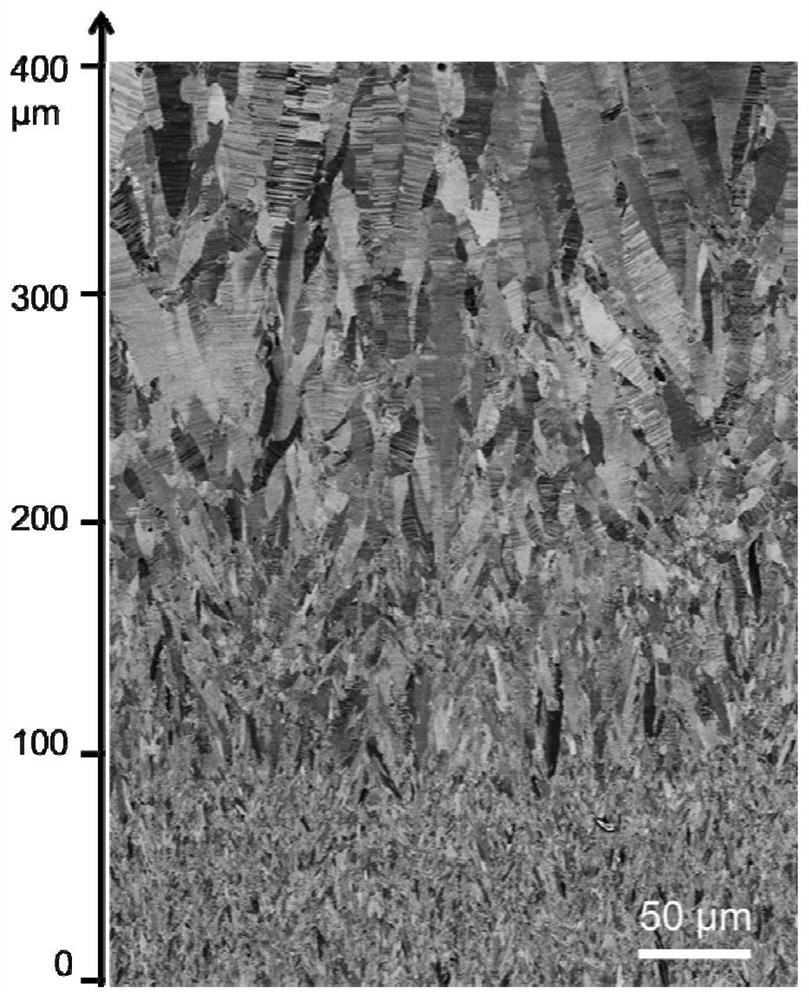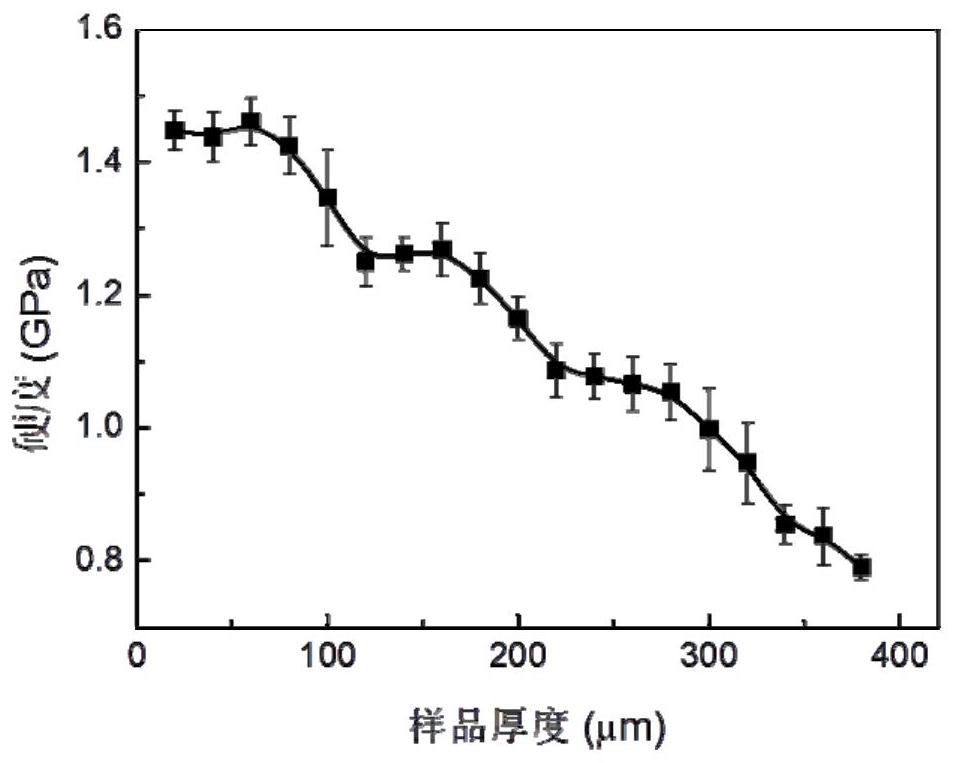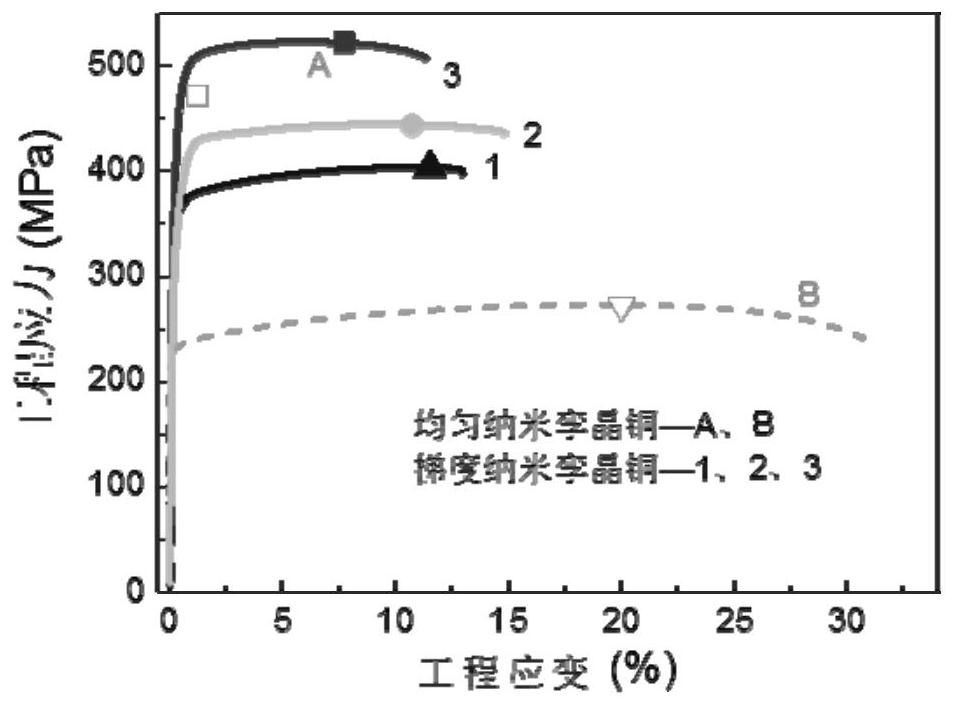A method to improve the mechanical properties of materials by changing the gradient nano-twin structure of metallic materials
A metal material, nano-twin technology, applied in nanotechnology, optics, electrolysis process, etc., can solve the problem that metal materials are difficult to have both high strength and good plasticity, and achieve high strength, increased yield strength, and increased work hardening rate. Effect
- Summary
- Abstract
- Description
- Claims
- Application Information
AI Technical Summary
Problems solved by technology
Method used
Image
Examples
Embodiment 1
[0044] Gradient nano-twin structure copper material, the total thickness of the sample is 400 μm. The sample is composed of micron-sized columnar grains growing along the deposition direction. The grains contain high-density twin boundaries, and most of the twin boundaries are parallel to the growth surface. The pure copper material in this embodiment has a gradient layer. Along the thickness direction, the grain size and the thickness of the twinned lamellar layer in the material show a monotonously increasing gradient change, and the average grain size gradually transitions from 2.5 μm to 15.8 μm. The wafer layer thickness gradually transitions from 29nm to 72nm, such as figure 1 shown.
[0045] In this embodiment, the microhardness of the gradient nano-twinned copper material gradually decreases along the thickness direction, from 1.5GPa to 0.8GPa, showing a gradient distribution, with a structural gradient of 1.75GPa / mm, such as figure 2 shown.
[0046] In this embodim...
Embodiment 2
[0048] The difference from Example 1 is:
[0049] The gradient nano-twinned copper material has 2 gradient layers. Along the thickness direction, the grain size and the thickness of the twinned lamellar layers of the material show a symmetrical gradient change that first increases and then decreases, as shown in Figure 4 shown.
[0050] In this embodiment, the cross-sectional hardness of the gradient nano-twinned copper material first decreases and then increases along the thickness direction, and the structural gradient is 3.2GPa / mm, such as Figure 5 shown.
[0051] In this embodiment, the room temperature stretching of the gradient nano-twin structure copper material: when the stretching rate is 5×10 -3 the s -1 , the yield strength is 437±19MPa, the tensile strength is 471±18MPa, the uniform elongation is 9.2±1%, and the elongation at break is 14±1.9%, such as Figure 4 Shown in curve 2.
Embodiment 3
[0053] The difference from Example 1 is:
[0054] The gradient nano-twin structure copper material has 8 gradient layers. Along the thickness direction, the grain size and the thickness of the twinned lamellar layer of the material show a four-period gradient change that first increases and then decreases, and its microstructure is shown in Image 6 shown.
[0055] In this embodiment, the hardness of the copper material with gradient nano-twinned structure shows a four-period gradient change along the thickness direction, which first decreases and then increases, and the structural gradient is 11.6GPa / mm, as Figure 7 shown.
[0056] In this embodiment, the room temperature stretching of the gradient nano-twinned copper material: when the stretching rate is 5×10 -3 the s -1 , the yield strength is 481±15MPa, the tensile strength is 520±12MPa, the uniform elongation is 7±0.5%, and the elongation at break is 11.7±1.3%. Such as Figure 4 Shown in curve 3.
[0057] It can b...
PUM
| Property | Measurement | Unit |
|---|---|---|
| size | aaaaa | aaaaa |
| thickness | aaaaa | aaaaa |
| yield strength | aaaaa | aaaaa |
Abstract
Description
Claims
Application Information
 Login to View More
Login to View More - R&D
- Intellectual Property
- Life Sciences
- Materials
- Tech Scout
- Unparalleled Data Quality
- Higher Quality Content
- 60% Fewer Hallucinations
Browse by: Latest US Patents, China's latest patents, Technical Efficacy Thesaurus, Application Domain, Technology Topic, Popular Technical Reports.
© 2025 PatSnap. All rights reserved.Legal|Privacy policy|Modern Slavery Act Transparency Statement|Sitemap|About US| Contact US: help@patsnap.com



